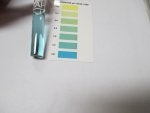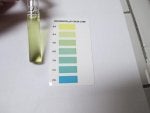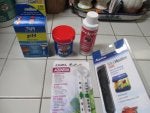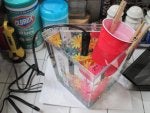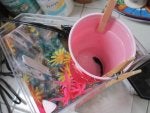Background:
Housing
What size is your tank - 1 gallon
What temperature is your tank - N/A, I don't have a thermometer or heater, but the water does feel warm.
Does your tank have a filter - No
Does your tank have an air stone or other type of aeration? - Pump with an air stone
Is your tank heated? - No
What tank mates does your betta fish live with? - None
Food
What type of food do you feed your betta fish? - TetraMin Tropical Flakes
How often do you feed your betta fish? - Every other day.
Maintenance
How often do you perform a water change? - When the water begins to look unclear.
What percentage of the water do you change when you perform a water change? - Full water change.
What type of additives do you add to the water when you perform a water change? - No additives
Water Parameters:
Have you tested your water? If so, what are the following parameters?
Ammonia: N/A
Nitrite: N/A
Nitrate: N/A
pH: N/A
Hardness: N/A
Alkalinity: N/A
I use 1 gallon of drinking water.
Symptoms and Treatment
How has your betta fish's appearance changed? - Loss of color (more below).
How has your betta fish's behavior changed? - Dramatically reduced activity; stays mostly at the bottom (more below).
When did you start noticing the symptoms? - approximalely 2-3 weeks ago?
Have you started treating your fish? If so, how? - Began treatment February 08, 2013 with 1 dose of Bettafix.
Does your fish have any history of being ill? - No prior history.
How old is your fish (approximately)? - Approximately 20 months
The usual tank conditions for my male Betta (in addition to the above):
4 artificial plants,
glass aquarium gravel,
I've had him for almost two years and up to this point, he hasn't had any problems that I'm aware of. I believe on January 18th of this year I performed a full water change and changed the gravel. Instead of using my usual glass aquarium gravel, I switched to Spectrazone Permaglo Black Lagoon for Freshwater Aquariums, which is advertised as not affecting water pH and having a non-toxic coating. The reason I switched is because there have been a few times in the past when I noticed that my Betta's fins would get wedged in between the glass aquarium gravels and he'd have a hard time getting himself out. I thought the gravel would be safer for him.
Within two days of having the new gravel in the aquarium, I noticed that the water was slightly cloudy. My fish seemed fine and I decided to monitor the water to see if the cloudiness worsened. It did not, but I noticed that my Betta, who is normally a dark blue, was getting slightly pale underneath his gills. He was still active and swimming and eating and everything seemed fine, so I decided to just keep an eye on him.
Then on Wednesday of this week, I noticed that the paleness had worsened and spread to the actual gill area (side of his head) and along the length of the lower half of his body. So I did a full water change and got rid of the Spectrazone gravel and went back to the glass aquarium gravel that I had been using. Along with his loss of color, he is spending most of the time at the bottom of the tank and is slightly tilted. He only comes up every once in a while for air and then goes back to the bottom.
I tried feeding him on Wednesday night, and it seemed like he was trying to eat, but he was struggling to get to the top and he didn't eat very much.
Last night I went to Petsmart and bought a bottle of Bettafix and have since used one dose (1/2 tsp per gallon of water). I know it's only been one dose, but I don't see any improvement. I just tried to feed him and he does have an appetite, but he is not eating as much. I think he struggles to be at the top of the tank to get to his food, so he only ate a little and then returned to the botton of the tank. I've thought about lowering the water level so he doesn't have to struggle as much, but I'm worried about how to measure out the proper dosage of the Bettafix since there will no longer be 1 gallon of water in the tank.
I've been to several websites and I don't know if what he has is bacterial or fungal or internal or external. And there seem to be so many different antibiotics and remedies. I thought about using aquarium salt, but I didn't want to add too much too soon with the Bettafix. Also, someone asked a similar question on bettatalk.com, and the woman recommended Kanacyn, but I haven't been able to find it and I didn't want to delay treatment any longer. I almost perchased Maracyn-Two, but it didn't list Bettas among
the fish it treats, and it comes in packets that are to be used in 10 gallon tanks, so I didn't want to risk overdosing my fish in his 1 gallon tank if I measured improperly.
In addition, I've read about people giving their Bettas boiled peas? Can anyone elaborate on why this is done and exactly how to prepare the peas?
I feel so absolutely guilty for not being more on top of things and removing him and changing the water the instant I noticed the water was cloudy. I thought I was doing things properly, but apparently not (not using aquarium salt or heater; more frequent water changing).
I can't be sure that the Spectrazone gravel is at fault, but there seems to be a correlation. Any help is greatly appreciated. I am attaching photos of what my fish currently looks like. Thank you.
Housing
What size is your tank - 1 gallon
What temperature is your tank - N/A, I don't have a thermometer or heater, but the water does feel warm.
Does your tank have a filter - No
Does your tank have an air stone or other type of aeration? - Pump with an air stone
Is your tank heated? - No
What tank mates does your betta fish live with? - None
Food
What type of food do you feed your betta fish? - TetraMin Tropical Flakes
How often do you feed your betta fish? - Every other day.
Maintenance
How often do you perform a water change? - When the water begins to look unclear.
What percentage of the water do you change when you perform a water change? - Full water change.
What type of additives do you add to the water when you perform a water change? - No additives
Water Parameters:
Have you tested your water? If so, what are the following parameters?
Ammonia: N/A
Nitrite: N/A
Nitrate: N/A
pH: N/A
Hardness: N/A
Alkalinity: N/A
I use 1 gallon of drinking water.
Symptoms and Treatment
How has your betta fish's appearance changed? - Loss of color (more below).
How has your betta fish's behavior changed? - Dramatically reduced activity; stays mostly at the bottom (more below).
When did you start noticing the symptoms? - approximalely 2-3 weeks ago?
Have you started treating your fish? If so, how? - Began treatment February 08, 2013 with 1 dose of Bettafix.
Does your fish have any history of being ill? - No prior history.
How old is your fish (approximately)? - Approximately 20 months
The usual tank conditions for my male Betta (in addition to the above):
4 artificial plants,
glass aquarium gravel,
I've had him for almost two years and up to this point, he hasn't had any problems that I'm aware of. I believe on January 18th of this year I performed a full water change and changed the gravel. Instead of using my usual glass aquarium gravel, I switched to Spectrazone Permaglo Black Lagoon for Freshwater Aquariums, which is advertised as not affecting water pH and having a non-toxic coating. The reason I switched is because there have been a few times in the past when I noticed that my Betta's fins would get wedged in between the glass aquarium gravels and he'd have a hard time getting himself out. I thought the gravel would be safer for him.
Within two days of having the new gravel in the aquarium, I noticed that the water was slightly cloudy. My fish seemed fine and I decided to monitor the water to see if the cloudiness worsened. It did not, but I noticed that my Betta, who is normally a dark blue, was getting slightly pale underneath his gills. He was still active and swimming and eating and everything seemed fine, so I decided to just keep an eye on him.
Then on Wednesday of this week, I noticed that the paleness had worsened and spread to the actual gill area (side of his head) and along the length of the lower half of his body. So I did a full water change and got rid of the Spectrazone gravel and went back to the glass aquarium gravel that I had been using. Along with his loss of color, he is spending most of the time at the bottom of the tank and is slightly tilted. He only comes up every once in a while for air and then goes back to the bottom.
I tried feeding him on Wednesday night, and it seemed like he was trying to eat, but he was struggling to get to the top and he didn't eat very much.
Last night I went to Petsmart and bought a bottle of Bettafix and have since used one dose (1/2 tsp per gallon of water). I know it's only been one dose, but I don't see any improvement. I just tried to feed him and he does have an appetite, but he is not eating as much. I think he struggles to be at the top of the tank to get to his food, so he only ate a little and then returned to the botton of the tank. I've thought about lowering the water level so he doesn't have to struggle as much, but I'm worried about how to measure out the proper dosage of the Bettafix since there will no longer be 1 gallon of water in the tank.
I've been to several websites and I don't know if what he has is bacterial or fungal or internal or external. And there seem to be so many different antibiotics and remedies. I thought about using aquarium salt, but I didn't want to add too much too soon with the Bettafix. Also, someone asked a similar question on bettatalk.com, and the woman recommended Kanacyn, but I haven't been able to find it and I didn't want to delay treatment any longer. I almost perchased Maracyn-Two, but it didn't list Bettas among
the fish it treats, and it comes in packets that are to be used in 10 gallon tanks, so I didn't want to risk overdosing my fish in his 1 gallon tank if I measured improperly.
In addition, I've read about people giving their Bettas boiled peas? Can anyone elaborate on why this is done and exactly how to prepare the peas?
I feel so absolutely guilty for not being more on top of things and removing him and changing the water the instant I noticed the water was cloudy. I thought I was doing things properly, but apparently not (not using aquarium salt or heater; more frequent water changing).
I can't be sure that the Spectrazone gravel is at fault, but there seems to be a correlation. Any help is greatly appreciated. I am attaching photos of what my fish currently looks like. Thank you.





